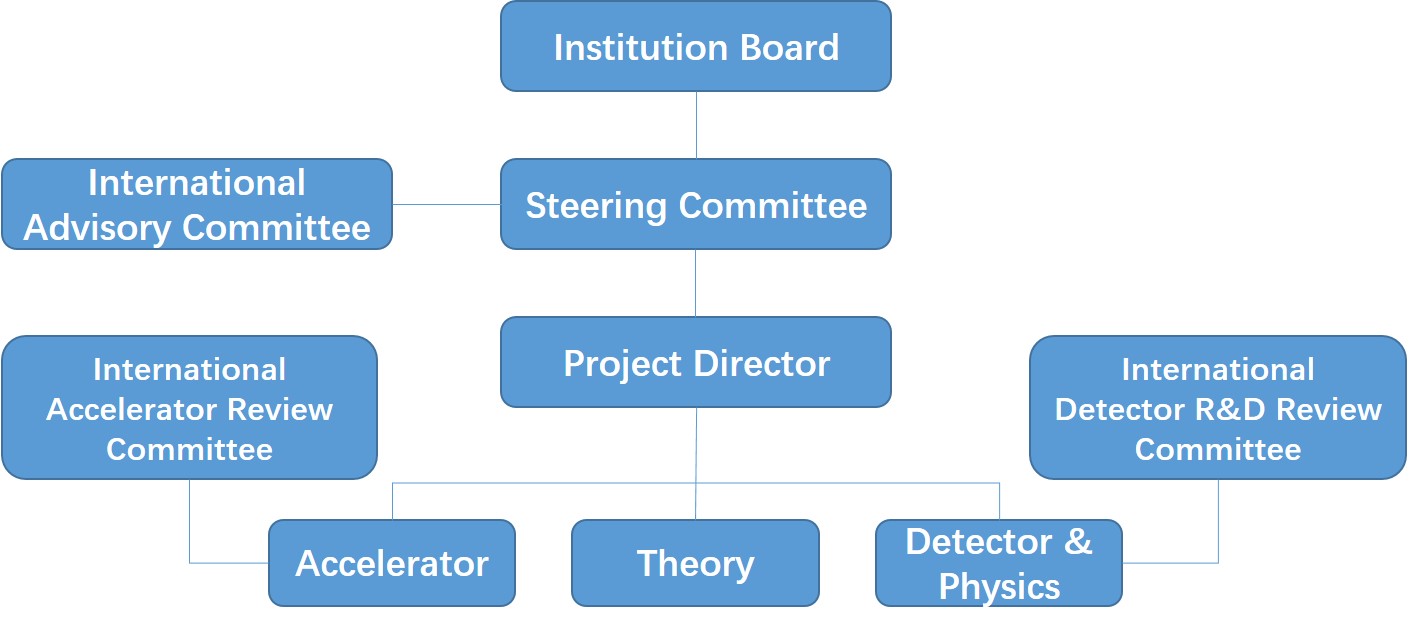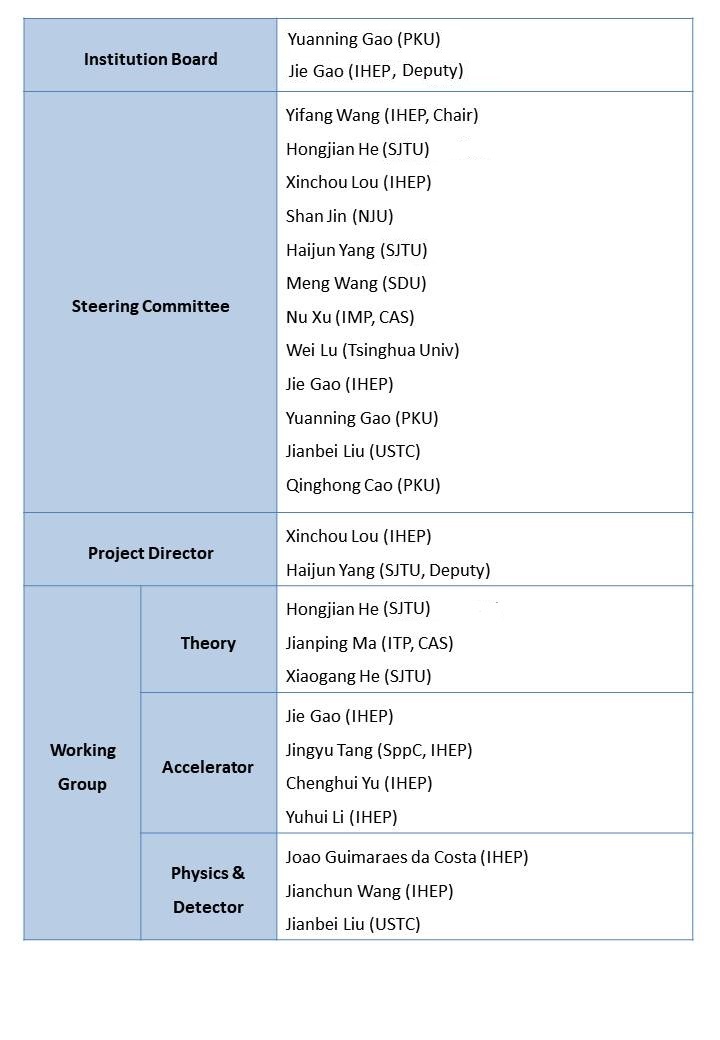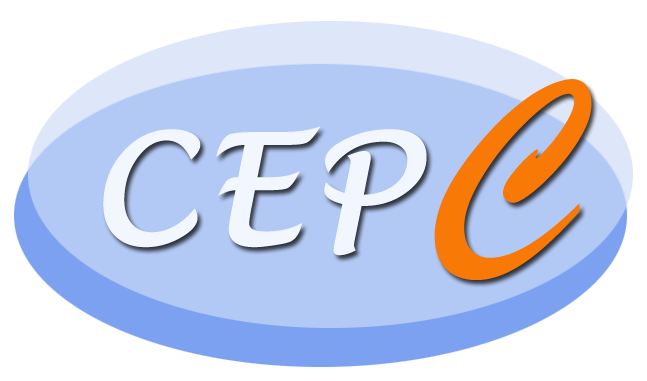The organization structure was officially formed in the kick-off
meeting in September 2013. It consists of the Institute Board (IB)
with representatives from each institution in the project; the
Steering Committee (SC) with members appointed by the IB; the
International Advisory Committee with experts from various fields providing
consult to the SC; the Project Director appointed by the SC and in
direct charge of the three working groups, Theory, Accelerator, and
Detector & Physics. In 2019, the International Accelerator Review Committee and the International Detector R&D Review Committee were formed.


International Advisory Committee

|
|
International Accelerator Review Committee
- Phillip Bambade, IJCLab
- Maria Enrica Biagini (chair), INFN
- Brian Foster, Oxford/DESY
- Kazuro Furukawa, KEK
- Xiaoye He, USTC
- Roberto Kersevan, CERN
- In-Soo Ko, Postech
- Michael Koratzinos, CERN
- Gero Kube, DESY
- Eugene Levichev, BINP
- Hiroyuki Nakayama, KEK
- Norihito Ohuchi, KEK
- Katsunobu Oide, KEK/CERN
- Carlo Pagani, INFN-Milano
- Paolo Pierini, ESS
- Anatoly Sidorin, JINR
- Steinar Stapnes, CERN
- Makoto Tobiyama, KEK
- Akira Yamamoto, KEK
- Zhentang Zhao, SINAP
International Detector Review Committee
- Daniela Bortoletto (Chair), Oxford
- James Brau, Oregon
- Anna Colaleo, INFN, Bari
- Paul Colas, Saclay
- Christophe De La Taille, OMEGA, CNRS
- Cristinel Diaconu, CPPM
- Frank Gaede, DESY
- Colin Gay, UBC
- Liang Han, USTC
- Bob Kowalewski, U Victoria
- Gregor Kramberger, IJS
- Roman Poeschl, IJCLab
- Burkhard Schmidt, CERN
- Tommaso Tabarelli de Fatis, INFN Milano-Bicocca
- Roberto Tenchini, INFN, Pisa
- Maxim Titov, Saclay
- Ivan Villa Alvarez, Santander
- Hitoshi Yamamoto, Tohoku U., Valencia
- Akira Yamamoto, KEK
|
CEPC
Working Groups
Three working groups have been formed to coordinate pre-studies for
the CEPC project. Activities of each group are briefly described
below and you can find out more from their regular meetings (link to
indico).
Accelerator
Working Group
--- conveners: Jie Gao (IHEP), Jingyu Tang (IHEP)
, Chenghui Yu (IHEP), Yuhui Li (IHEP)
|
The Accelerator WG are pursuing an optimized parameter design of a
circular electron positron collider by using analytical expression
of maximum beam-beam parameter and beamstrahlung beam lifetime from
given design goal and technical limitations. The first study on the
machine parameters has been published (reference) and there are
on-going efforts on the following topics:
-
Global parameter
optimization
-
Beamstrahlung
effect
-
Final focus system
design
-
Dynamic
aperture and momentum acceptance study
-
Pretzel scheme
design
The AC Power consumption is critical for the machine but you can
perform a quick estimation yourself with the light-weighted program
developed by Dr. Song Jin. Click to run! |
|
Theory
Working Group
--- conveners: Hongjian He (SJTU),
Jianping Ma (ITP), XiaoGang He (SJTU)
|
The group is focused on the physics potential of both the
electron-positron collider at 240-250 GeV and the proton-proton
collider with much higher energy. Seven sub-groups have been formed,
covering the following topics:
-
Standard Model (SM):
SM will be tested in
even higher precision at CEPC/SPPC, and it is also the
foundations to claim new discovery. The precision of SM
predictions must coincide with the experimental one and lots of
theoretical works are needed.
-
Higgs Physics: This
group will focus on the Higgs physics in the SM and BSM and
explore the motivations and behaviors of SM-like Higgs boson and
extended Higgs sectors
-
Beyond SM– Supersymmetry:
Supersymmetry is the popular candidate of BSM. This group will
explore how the CEPC/SPPC can discover the supersymmetry and
measure the corresponding parameters
-
Beyond SM – Alternatives:
The goals of this group are similar with
supersymmetry group except for alternative BSM, for example the
extra dimension models, little Higgs models, dynamical symmetry
breaking models etc.
-
Flavor Physics:
This group will explore what kind of flavor
physics can be carried out and how it can complement to the
direct measurements
-
TeV Scale Cosmology:
This group will explore the
interplay between collider physics and cosmology
-
Monte Carlo Tools:
This group will develop tools to bridge theory
and experiment
In
short, the elucidation of the mechanism of electro-weak symmetry
breaking and exploration of possible physics beyond the standard
model need the hard work and cooperation between theorists and
experimentalists. The status of this Theory WG is summarized in this
talk. |
|
Physics & Detector Working Group
--- conveners: Joao Barreiro Guimaraes Costa
(IHEP), Jianchun Wang (IHEP), Jianbei Liu (USTC)
|
This working group is responsible for R&D on detectors, detector
optimization and physics studies. It consists of 5 subgroups, namely
Vertex, Tracker, Calorimeter and Physics. Besides the critical
technologies for each sub-detector, the group are also pursuing
efforts on the following topics:
-
SM
Higgs properties precision measurements
-
SM precision
measurements and New Physics searches
-
Detector geometry
optimization
-
Reconstruction
algorithm development and optimization
-
Interface to
accelerator and beam conditions
|
|
Join us if you are
interested!
You may contact the conveners directly or inform us through the
“Join
US” on this web. |



